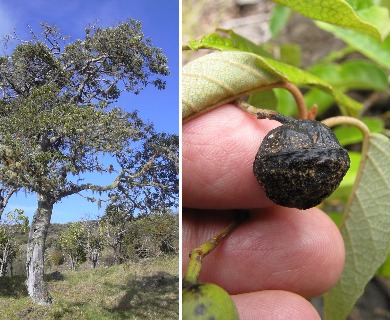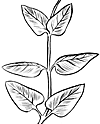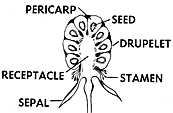Hawai'i Kauilatree
Alphitonia ponderosa
Buckthorn family (Rhamnaceae)
Native species ()
Medium-sized to large handsome tree of dry forests characterized by rusty hairs on twigs, leaf-stalks, flower stalks, and under surface of the young leaves, by lateral clusters of small greenish flowers spreading like a five-pointed star, and by rounded ringed near the middle. To 50–80 ft (15–24 ) high with straight trunk 8–24 inches (0.2–0.6 ) in diameter, or only a shrub on exposed ridges. Bark whitish gray, rough and furrowed. Twigs with raised half-round leaf scars and rusty hairy buds composed of minute leaves.

©2003 Forest And Kim Starr
Flower clusters () at leaf bases, shorter than leaves, with widely forking hairy branches. Flowers several, of one or both sexes (polygamous), short-stalked, about 1⁄4 inch (6 ) across. The short cuplike base () bears five spreading pointed hairy more than 1⁄16 inch (1.5 ) long; five narrow spoon-shaped petals half as long and partly enclosing the five and with one celled covered by a broad rounded and with a short 2–3-forked
() is about 5⁄8 inch (15 ) in diameter, with a ring formed by a cuplike base, containing two or three stones. Seeds are oblong, shiny, with red covering.
The wood has a beautiful cherry red or dark red color with wide light yellowish brown sapwood. It has distinct growth rings and is diffuse, porous, fine-textured, very hard, strong, and durable. One of the heaviest native woods, it sinks in water. It was highly valued by the Hawaiians and served as tools in the absence of metals. The many uses hut beams, mallets for beating tapa cloth, spears 13–20 ft (4–6 ) long, javelins, and the o’o or digging stick for cultivating fields. The lintels above the windows of the Hawaiian Mission Printing House, built in 1821, were of this wood and were quite sound when removed for restoration in 1972. Rounded polished rods of the wood became hairpins for women.
Widespread in the lower dry forest on the leeward side of the six large Hawaiian Islands, sometimes on exposed ridges and on aa lava fields at 800–4100 ft (244–1250 ) elevation in koa forest. Rare except on Kauai.
Special areas
Kokee, Volcanoes
Champion
Height 62 ft (18.9 ), c.b.h. 7 ft (2.1 ), spread 54 ft (16.5 ). Kokee State Park, Kauai (1968).
Range
Known only from the Hawaiian Islands.
Other common name
Botanical
Alphitonia excelsa auth., not (Fenzl) Reiss. ex Endl.
St. John (1977a) has distinguished six varieties, each restricted to a separate island.







